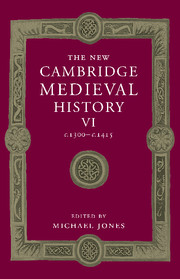Book contents
- Frontmatter
- Part I General Themes
- Part II The States of the West
- Part III The Church and Politics
- 19 The Avignon Papacy
- 20 The Great Schism
- Part IV Northern and Eastern Europe
- Appendix Genealogical Tables
- Primary Sources and Secondary Works Arranged by Chapter
- Index
- Frontispiece
- Plate section
- Map 4 Europe's trade, c. 1300
- Map 5 Europe's trade, c. 1400
- Map 7 The Hundred Years War to 1360
- Map 15 Russia, c. 1396
- Map 17 The Byzantine empire in the 1340s
- References
20 - The Great Schism
from Part III - The Church and Politics
Published online by Cambridge University Press: 28 March 2008
- Frontmatter
- Part I General Themes
- Part II The States of the West
- Part III The Church and Politics
- 19 The Avignon Papacy
- 20 The Great Schism
- Part IV Northern and Eastern Europe
- Appendix Genealogical Tables
- Primary Sources and Secondary Works Arranged by Chapter
- Index
- Frontispiece
- Plate section
- Map 4 Europe's trade, c. 1300
- Map 5 Europe's trade, c. 1400
- Map 7 The Hundred Years War to 1360
- Map 15 Russia, c. 1396
- Map 17 The Byzantine empire in the 1340s
- References
Summary
1378 and its consequences
the southern French popes who ruled the universal Church from Avignon during most of the fourteenth century brought papal monarchy and the papalist ecclesiology that justified it to their highest pitch. What drove them chiefly was the need for enormously higher revenues to finance the endless wars that they fought to subdue the Papal States in Italy. For at the core of Avignon’s papal monarchy was a rampant ‘fiscalism’ in which the steady extension of papal rights of provision to benefices steadily generated new or heightened impositions on clerical revenues. But the communes and signorie of the Papal States never learned to accept their French overlords and in 1375 they joined Florence in war against them. The seventh Avignon pope, Gregory XI (1370–8), realising that papal domination could not be consolidated from afar, gave ear to pious voices urging a return to Rome and decided to make the move; he left Avignon in 1376 along with seventeen of his twenty-three cardinals and hundreds of officials of the papal curia, mostly French; only six cardinals and a reduced staff were left behind. The papal party entered Rome on 17 January 1377; just over a year later Gregory was dead.
- Type
- Chapter
- Information
- The New Cambridge Medieval History , pp. 674 - 696Publisher: Cambridge University PressPrint publication year: 2000
References
- 3
- Cited by

